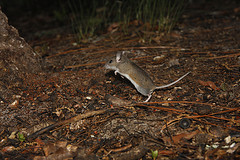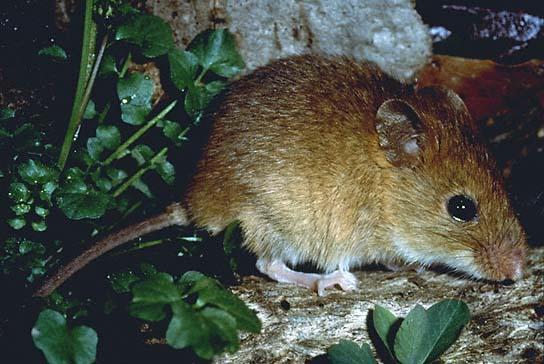Cotton Mouse: (Peromyscus gossypinus)
The cotton mouse (peromyscus gossypinus) is one of the largest members of the genus peromyscus, belongs to the cricetidae family. They average between 7 to 8 inches long including its tail, weighing between 1/2 an ounce to 2 ounces.
The cotton mouse has short dark brown fur covering its upper body, with longer darker fur covering the middle of its body. Its under – parts are a pale whitish color. Their eyes are big, round and black in color, its tail is lightly furred and short. Their ears are very lightly furred and long. They have 4 toes in on their front paws and 5 on their paws. Their teeth are sharp and they use them for gnawing. Cotton mice are native to North America and can be found throughout most parts of the southeastern United States, including Florida. They prefer to inhibit areas such as swamps, wetlands, sand dunes, wooded areas along banks and streams, fields and old or abandoned structures. Primarily inhibiting burrows that were once occupied by tortoises.
Cotton mice are omnivorous and will consume both plant and animals. They consume seeds, fruits, nuts, insects and other invertebrates.
The cotton mouse is secretive and solitary. They are nocturnal and primarily active at night, due to its predators. Cotton mice can dig well and create burrows underground for shelter as well as construct nest in trees, or under logs and bushes. Once they have established a home range, which the males territory tends to be larger than the females, it begins searching for food and water sources. Cotton mice do not hibernate, however in the summer during the high temperatures they become dormant. Cotton mice communicate by using scent, vocals and tactile movements. When using their vocals they will emit high pitched squeaks and buzzing sounds, they are also known to thumb their back paws on the ground, producing a drumming like sound. The cotton mouse has a short life span, usually averaging 4 to 5 months, maybe up to 14 months. The main reason for their short life spans is due to their predators. It has been stated by Le Conte they often used cotton for the construction of the nest giving it the name the cotton mouse. Females can start breeding between 5 to 10 weeks old and in Florida the cotton mouse breeds year round, producing 4 litters each breeding season. With litters being born approximately every 30 days, 1 to 7 young can be born, usually the average litter is between 1 to 3 young. Their gestational period is between 20 to 23 days long. When the young are born they are fur – less, eyes are closed and their incisors are underneath the gum – line. They begin to show signs of grayish colored fur around day 5 and on day 7 their incisors are visible, by day 10 they appear fully aware and are responding, on day 12 they open their eyes. Within two weeks they will double in size and reach 93% of its adult size by 60 days. The females raises and provides all the care for its young without the help of the male. When the young reach 3 to 4 weeks, they are completely weaned and ready for their independence.
The cotton mouse is known to carry salmonellosis, which can be transmitted to humans.
Cotton mice cause very little to no damage to cotton or foodstuffs.


